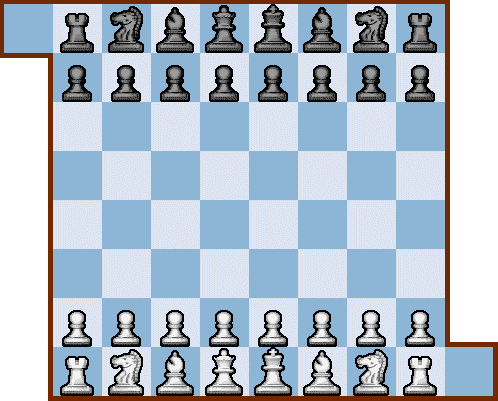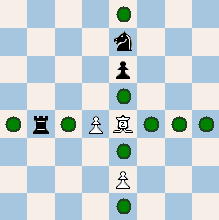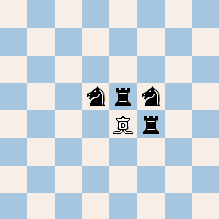

The differences compared with orthochess are the extra corner squares and the extended castling. Besides normal castling one can choose to move the king three squares instead of two. The rook ends up on its usual square. The corner square provides a hiding nest for the king should the player want to invoke play on the same wing and advance with the pawns. The extended castle rule also makes play on the wings easier to achieve. Queenside castle becomes more attractive. The extra corner squares will enhance the strategical possibilities.
Try placing the king on the extra corner square, advance the g-pawn (or b-pawn), and follow up with rooks from behind. The king will be safe and will not stand in the way of the rooks.
Neoorthodox Chess can be played with an extra piece placed on the extra square.
(1) The Divaricator captures by withdrawing from one or two adjacent pieces positioned at an angle versus the movement direction. If it moves away orthogonally it captures the diagonally adjacent pieces. If it moves away diagonally it captures the orthogonally adjacent pieces. The Divaricator has the value of a bishop + pawn (my estimate).
An important facet of the Divaricator is that K + Divaricator versus K is won. It is easy to achieve mate. Typically, one must drive the king toward the edge and place the Divaricator orthogonally adjacent to the enemy king. Withdrawal capture derives from Madagascan game Fanorona. Forked withdrawal capture is probably new.
(2) The Zeppelin flies to any empty square orthogonally, ie. the rook-directions. It captures an enemy piece by landing immediately beyond its victim. On this board the Zeppelin's value corresponds to a bishop (preliminary estimate).
The Zeppelin cannot force a mate together with a king. The defending party can step into the corner. If you advance too boldly with the pawns, they can easily become victims of the Zeppelin. The Zeppelin piece is a weaker version of the Airplane, which was invented by R. W. Schmittberger for his Airplane Chess, 1981.
(3) The Amiral
(4) The Adjutant slides in any direction, but on the orthogonals it slides only on one colour. The opposite colour squares are simply ignored. The Adjutant's value is 5, that is, the same as a rook. The Adjutant is really an enhanced bishop that can also move orthogonally. Its main weakness is that it cannot give mate together with the king.
 Disregarding the situation on the rest of the board, this illustrates how convenient the extra corner square is when launching an attack on the wing.
Disregarding the situation on the rest of the board, this illustrates how convenient the extra corner square is when launching an attack on the wing.
 The Zeppelin can move to any empty square orthogonally. The rook and the knight can be captured.
The Zeppelin can move to any empty square orthogonally. The rook and the knight can be captured.
 Moving away one or two squares to the south the Divaricator can capture both the knights. Moving away to the southwest, the Divaricator can capture both rooks.
Moving away one or two squares to the south the Divaricator can capture both the knights. Moving away to the southwest, the Divaricator can capture both rooks.
• You can download my free Neoorthodox Chess program here (updated 2008-11-26), but you must own the software Zillions of Games to be able to run it (I recommend the download version).
• Don't miss my other chess variants.
© M. Winther 2007 May